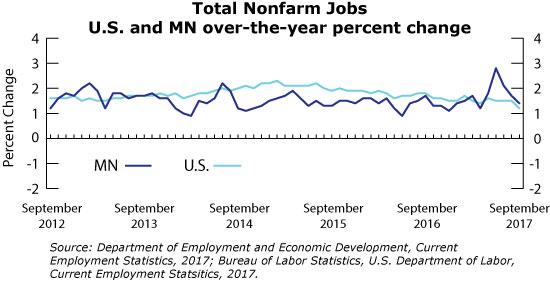by Nick Dobbins
October 2017
Monthly analysis is based on unadjusted employment data.
Employment in the Minneapolis-St. Paul MSA was down very slightly in September, off by 909 jobs (0.0 percent). The MSA has had flat employment growth every September since 2013. As is generally the case this time of year, declines in other industries were countered by sharp growth in Government education employment (up 16,210 or 6.9 percent). Local Government Educational Services added 11,293 jobs or 14.7 percent. The most prominent job losses came in Leisure and Hospitality, which was off 4,988 (2.6 percent). Mining, Logging, and Construction also dropped sharply, losing 1,909 jobs or 2.1 percent. Annually metro area employment was up by 42,524 (2.1 percent). This is the third consecutive month of declines in the over-the-year employment growth rate. However, the region had the largest over-the-year change of any metro area in Minnesota, and it is the fifteenth consecutive month that the area’s growth rate has exceeded that of the state. All supersectors save two (Information and Financial Activities) added jobs. The biggest growth, both in proportional change and total jobs added, was once again Educational and Health Services (up 14,294 or 4.4 percent). Health Care and Social Assistance contributed all of the growth, as Educational Services lost 1,723 jobs (3.8 percent). The growth in health care was largely shared by three component sectors: Ambulatory Health Care Service (up 5,621 or 6.3 percent), Hospitals (up 3,200, 5.3 percent), and Social Assistance (up 6,575, 9.9 percent).
The Duluth-Superior MSA added 423 jobs (0.3 percent) in September. Unlike the state and Twin Cities metro, Duluth traditionally adds jobs in September, if only a few. Government led the growth, adding 2,004 jobs (8.2 percent), split between State (up 906 or 13.4 percent) and Local (up 1,102 or 6.9 percent) employment. Literally every other published supersector in Duluth lost jobs. The biggest decline, both proportionally and in actual jobs, came in Leisure and Hospitality, which was off by 526 (3.4 percent). Over the year Duluth added 1,839 jobs (1.3 percent). Mining, Logging, and Construction did most of the heavy lifting, adding 899 jobs (9.2 percent) on the year. Leisure and Hospitality added 345 jobs (2.4 percent), and Financial Activities grew by 164 (2.8 percent).
Employment in the Rochester MSA was down by 1,835 (1.5 percent) in September. It was the largest monthly decline of any MSA in the state. Rochester was also the only MSA to lose public sector jobs on the month, down 53 (0.4 percent). The steepest decline in the area came in Professional and Business Services (off 229 or 3.9 percent). Every published supersector in Rochester lost jobs in September. Over the year, employment in Rochester was up by 1,100 (0.9 percent). The only notable decline came in Trade, Transportation, and Utilities (down 243 or 1.3 percent), with losses in all three component sectors. Mining, Logging, and Construction had the most noteworthy growth, adding 385 jobs (8.1 percent).
Employment growth in the Saint Cloud MSA was largely flat in September as the MSA lost six jobs (0 percent). Seasonal gains in Government (up 898 or 6.5 percent) offset losses in most of the other supersectors. The only other industry group to add jobs for the month was Manufacturing (up 15 or 0.1 percent). The sharpest decline came in Leisure and Hospitality (down 360 jobs or 3.9 percent). Annually employment in the Saint Cloud MSA was up by 1,367 (1.2 percent). Two supersectors once again drove most of the over-the-year growth, as Mining, Logging, and Construction added 730 jobs or 10.2 percent, and Educational and Health Services added 736 jobs or 3.4 percent.
The Mankato-North Mankato MSA added 1,876 jobs (3.3 percent) in September. This was the second fastest growth of any MSA in Minnesota and the fastest of any MSA entirely within the state. Unlike most other MSAs, private sector employment in Mankato grew on the month, adding 516 jobs (1.1 percent). Annually the Mankato-North Mankato MSA added 691 jobs (1.2 percent). Goods producers added 304 jobs (3 percent), and service providers added 387 (0.8 percent).
The Fargo-Moorhead MSA added 2,823 jobs (2 percent) in September. While Government employment showed the largest growth (up 2,734 or 16.9 percent), private sector employers also added jobs (up 89 or 0.1 percent). Outside the public sector, the fastest growing supersector in both proportional and actual growth was Professional and Business Services, which added 203 jobs (1.2 percent). Annually the Fargo-Moorhead area added 2,718 jobs (1.9 percent). The only areas to shed jobs were Trade, Transportation, and Utilities (down 168 or 0.5 percent) and Information (down 119 or 3.6 percent).
The Grand Forks-East Grand Forks MSA added 2,342 jobs (4.2 percent) in September, the fastest monthly growth of any MSA in Minnesota. Government employers added 2,243 jobs (18.2 percent). In spite of the strong monthly growth, the Grand Forks-East Grand Forks MSA remained the only MSA in the state to lose jobs on an annual basis, down 1,176 (2 percent). The losses continued thanks to weak over-the-year performance in Mining, Logging, and Construction (down 1,143 or 23.8 percent).
